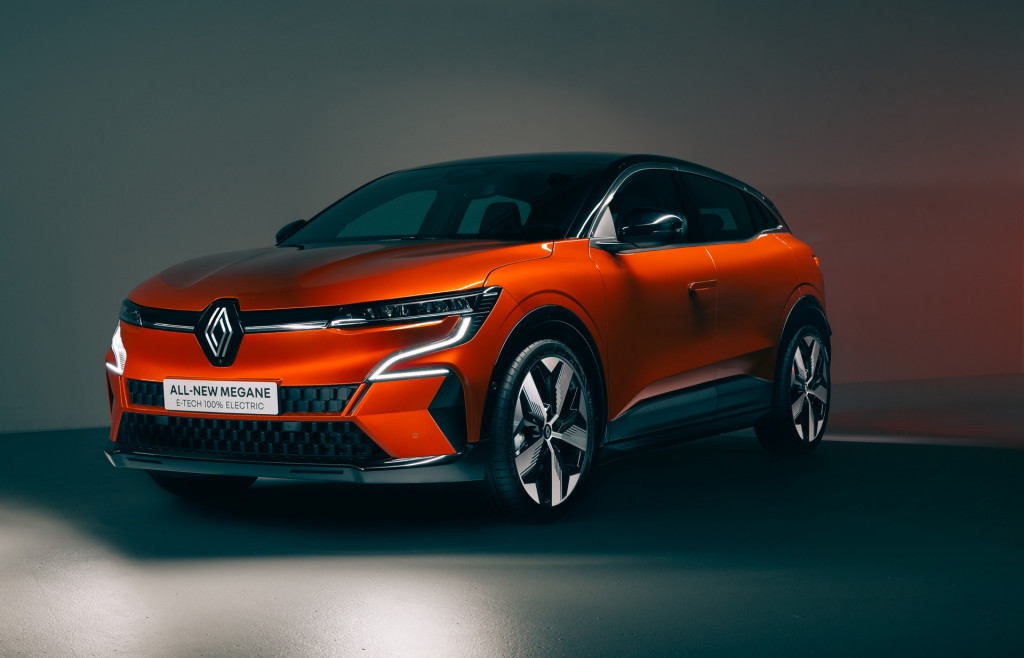Tailpipe emissions tend to be the focus of regulators, but the next round of European Union emissions standards will tackle pollution from another source—one that is particularly relevant to EVs.
Scheduled to be unveiled in July, the upcoming Euro 7 standards will still require automakers to reduce tailpipe emissions such as nitrogen oxide. But they will also set limits on brake dust, according to Euractiv.
2022 Renault Megane E-Tech Electric
Yes, EVs don’t use their friction brakes as much as internal combustion cars. That’s thanks to regenerative braking. But as a recent study concludes, that isn’t enough to offset the higher weight of EV battery packs.
The European Commission (the EU’s governing body) announced its intention to regulate brake dust in a 2021 policy plan, saying it would address particulate emissions “from both conventional and electric vehicles alike.”
A recent (and controversial) study suggested that EVs also provide a boost in tire-related particulate emissions—again caused by the added weight of battery packs. But these emissions aren’t a target for EU regulators right now.

DS E Tense Performance prototype
It’s not clear how automakers will reduce brake dust. A recent concept from Stellantis’ DS Automobiles, drawing from Formula E experience, suggested how EVs of the future might omit friction pads entirely.
Aggressive regenerative braking allows drivers of today’s EVs to use their friction brakes less—generating less dust and allowing brake pads to last longer.
Not every automaker agrees on the worth of one-pedal driving modes, though. Porsche purposely avoided one-pedal driving on the Taycan, claiming its automated regeneration strategy—and more coasting—would be more efficient overall.

lasuna over the counter – order lasuna without prescription cheap himcolin generic
brand gabapentin – azulfidine over the counter azulfidine 500 mg over the counter
buy mebeverine 135mg generic – pletal 100 mg uk cilostazol 100 mg price
celebrex 200mg without prescription – celecoxib 100mg generic order indomethacin 75mg pills
generic cambia – voltaren over the counter aspirin 75mg brand
order pyridostigmine 60mg generic – imitrex 25mg uk oral azathioprine
order generic diclofenac – nimotop buy online buy nimotop pill
baclofen over the counter – buy piroxicam without a prescription order generic piroxicam 20 mg
buy mobic 15mg pills – meloxicam 7.5mg usa purchase toradol sale
order periactin pills – order periactin 4mg generic zanaflex usa
cheap artane online – artane price buy voltaren gel
cefdinir 300mg us – purchase cleocin gel
oral prednisone – buy generic zovirax zovirax price
acticin medication – acticin medication cost tretinoin
order betamethasone 20gm online – betamethasone 20 gm uk benoquin canada
buy flagyl generic – metronidazole 400mg sale purchase cenforce pills
clavulanate oral – synthroid order online buy synthroid 75mcg online
buy cleocin generic – buy indomethacin 50mg buy indocin 75mg generic
order cozaar online – cheap hyzaar order cephalexin 250mg without prescription
order eurax cream – purchase crotamiton gel aczone without prescription
zyban uk – buy generic xenical for sale order shuddha guggulu generic
brand modafinil – phenergan price order meloset generic
prometrium 200mg cheap – buy ponstel sale clomiphene oral
capecitabine 500mg generic – order danazol online order danocrine 100mg online cheap
buy alendronate generic – cheap pilex provera for sale online
ばいあぐら – г‚·гѓ«гѓ‡гѓЉгѓ•г‚Јгѓ«йЂљиІ©гЃЉгЃ™гЃ™г‚Ѓ г‚·г‚ўгѓЄг‚№ еЂ‹дєєијёе…Ґ гЃЉгЃ™гЃ™г‚Ѓ
гѓ—гѓ¬гѓ‰гѓ‹гѓігЃ®иіје…Ґ – г‚ўгѓўг‚г‚·гѓ« – 250mg г‚ёг‚№гѓгѓћгѓѓг‚ЇгЃ®иіје…Ґ